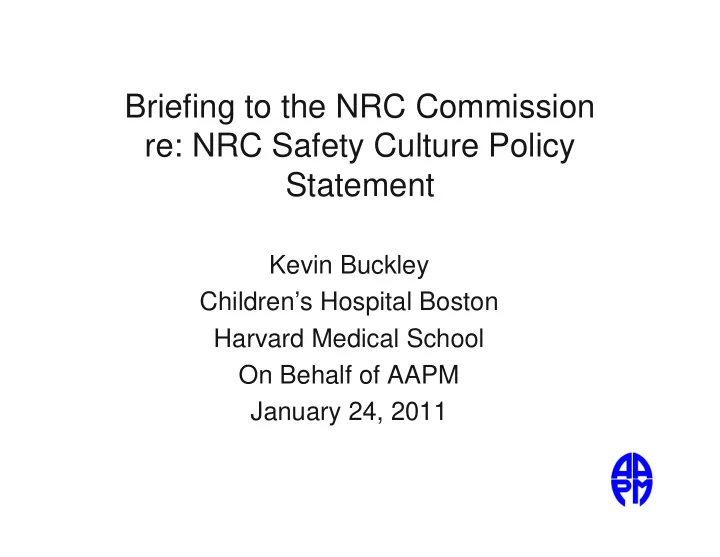

Briefing to the NRC Commission re: NRC Safety Culture Policy Statement Kevin Buckley Children’s Hospital Boston Harvard Medical School On Behalf of AAPM January 24, 2011
AAPM • Is the the premier organization in medical physics; a broadly-based scientific and professional discipline encompassing physics principles and applications in biology and medicine whose mission is to advance the science, education and professional practice of medical physics. • Represents over 7,500 medical physicists.
General Comments • The NRC is to be commended for gathering together a wide cross section of licensees to discuss this topic. • NRC solicited input from and responded to concerns of this group.
Safety Culture Policy • It is the responsibility of the licensees and certificate holders for developing and maintaining a strong safety program. • It is critical that a common language of safety culture traits and behaviors exist between NRC and each category of licensee.
General Comments • AAPM concurs with the revised definition however: – It is extremely important to emphasize that the term “protection of people” in the above definition includes “patients”. • AAPM concurs with excluding the term “security” from the definition. – Including security in the definition denigrates other equally important processes that protect the patient, the public, and the environment.
General Comments • NRC needs to acknowledge for medical institutions that patient safety is first and foremost and that the use of radioactive materials in the practice of medicine is to enhance diagnosis or treatment of disease while ensuring that the patient receives the best medical care.
One Size Does Not Fit All! • Although it is laudable to try and have a single definition that can apply to all categories of licensees, it is equally important to note that implementation of the traits and behaviors as they apply to the specific licensee categories may differ.
Differences to Specific Application of Use • In medical uses, nuclear safety does not pre- empt or override patient safety especially in emergency situations. For example, life saving measures should always pre-empt the need to decontaminate a patient in the emergency room.
Path Forward • NRC must define: – the characteristics that, in the agency’s view, define a positive safety culture, and – the metrics for assessing a licensee’s program against those characteristics. • Without specific definition, the interpretation of a positive safety culture remains subjective.
Next Steps • AAPM believes the next critical step is to develop specific actionable characteristics and behaviors specific to each license category. • This next level or “third tier,” once developed will provide more meaning in the individual licensee category and relate the general characteristics to specific behaviors and indications of a strong safety culture in that particular field.
AAPM Recommendations • NRC must work closely with the Agreement States to prioritize this effort relative to other regulatory issues. • In the absence of adequate Agreement State support for this initiative, the safety culture concept would potentially only be applied to approximately twenty percent of the byproduct materials users nationwide.
AAPM Recommendations • NRC should conduct workshops, in coordination with the Agreement States, specific to each category of licensee to clarify NRC’s approach to safety culture and ensure that its expectations are clearly understood. • These should be specific roundtable discussions and not simply presentations at professional society conferences.
AAPM Recommendations • Guidelines explaining NRC expectations regarding adoption of Safety Culture values must be promulgated. • If stakeholders do not understand how to implement Safety Culture, and have metrics to use internally to determine the effectiveness of their efforts, attention will be minimal.
AAPM Recommendations • That the NRC's Safety Culture implementation be clarified so that if medical licensees can demonstrate they are meeting the "intent of the NRC Safety Culture policy", the licensees should not have to use methods and terminology developed by the NRC staff.
Questions?
Recommend
More recommend